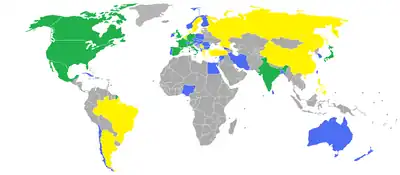
| World cinema |
|---|
World cinema is a term in film theory that refers to films made outside of the American motion picture industry, particularly those in opposition to the aesthetics and values of commercial American cinema.[1] The Third Cinema of Latin America and various national cinemas are commonly identified as part of world cinema. The term has been criticized for Americentrism and for ignoring the diversity of different cinematic traditions around the world.[1]
Types
World cinema has an unofficial implication of films with "artistic value" as opposed to "Hollywood commercialism." Foreign language films are often grouped with "art house films" and other independent films in DVD stores, cinema listings etc. Unless dubbed into one's native language, foreign language films played in English-speaking regions usually have English subtitles. Few films of this kind receive more than a limited release and many are never played in major cinemas. As such the marketing, popularity and gross takings for these films are usually markedly less than for typical Hollywood blockbusters. The combination of subtitles and minimal exposure adds to the notion that "World Cinema" has an inferred artistic prestige or intelligence, which may discourage less sophisticated viewers. Additionally, differences in cultural style and tone between foreign and domestic films affects attendance at cinemas and DVD sales.[2]
Foreign language films can be commercial, low brow or B-movies. Furthermore, foreign language films can cross cultural boundaries, particularly when the visual spectacle and style is sufficient to overcome people's misgivings. Films of this type became more common in the early 2000s, as Crouching Tiger, Hidden Dragon, Amélie, Brotherhood of the Wolf, Y Tu Mama Tambien and Talk to Her enjoyed great successes in United States cinemas and home video sales. The first foreign and foreign language film to top the North American box office was Hero in August 2004.[3] "The rule for foreign-language films is that if you've done $5 million or better (in United States cinemas), you've had a very nice success; if you do $10 (million) or better (in United States cinemas), you're in blockbuster category," Warner Independent Pictures ex-president Mark Gill said.[4]
On the other hand, English-dubbed foreign films rarely did well in United States box office (with the exception of anime films). The 1982 United States theatrical release of Wolfgang Petersen's Das Boot was the last major release to go out in both original and English-dubbed versions, and the film's original version actually grossed much higher than the English-dubbed version.[5][6] Later on, English-dubbed versions of international hits like Un indien dans la ville, Godzilla 2000, Anatomy, Pinocchio and High Tension flopped at United States box office.[7][8][9][10] When Miramax planned to release the English-dubbed versions of Shaolin Soccer and Hero in the United States cinemas, their English-dubbed versions scored badly in test screenings in the United States, so Miramax finally released the films in United States cinemas with their original language.[10][11]
See also
- Art cinema
- Awards
- AACTA Awards
- Academy Award for Best International Feature Film
- British Academy Film Awards
- Canadian Screen Awards
- César Award for Best Foreign Film
- Golden Globe Awards
- Jutra Award
- List of Academy Award winners and nominees for Best International Feature Film
- List of Academy Award-winning films
- List of foreign-language films nominated for Academy Awards
- Online Film Critics Society Award for Best Foreign Language Film
- Dhaka University Film Society
- Documentary film
- Ethnocinema
- Eurocinema
- Experimental film
- Film award
- Film festival
- Film industry
- Film preservation
- Film society
- Filming location
- Filmmaking
- History of film
- Independent film
- International co-production
- Language cinema
- List of box-office bombs
- List of cinema of the world
- List of film festivals
- Lists of highest-grossing films
- Mainstream film
- National cinema
- Production company
- SBS World Movies
- Short film
- Subtitles
- Transnational cinema
- World Cinema Foundation
- World premiere
References
- 1 2 Nagib, Lúcia. "Towards a positive definition of world cinema." Remapping world cinema: Identity, culture and politics in film (2006): 30-37.
- ↑ Curran, Daniel. Foreign Films: More than 500 films on video cassette, pages v-vi. Evanston, Illinois: CineBooks, 1989.
- ↑ Brandon Gray (August 29, 2004). "'Hero' Soars to Late August Record". boxofficemojo.com. Archived from the original on October 4, 2007.
- ↑ "Foreign affairs". The Hollywood Reporter. 3 July 2009. Archived from the original on 3 July 2009. Retrieved 10 August 2018.
- ↑ "EDITORIAL: Life Isn't Beautiful Anymore, it's Dubbed". Indiewire.com. 23 August 1999. Retrieved 10 August 2018.
- ↑ "Will Dubbing Fly in the U.S.? Read My Lips - The New York Times". The New York Times. 5 August 2018. Archived from the original on 5 August 2018. Retrieved 10 August 2018.
- ↑ "LITTLE INDIAN': BIG MISTAKE - The Washington Post". Archive.today. 18 July 2018. Retrieved 10 August 2018.
- ↑ Pandya, Gitesh. "Weekend Box Office". Boxofficeguru.com. Retrieved 10 August 2018.
- ↑ Horn, John (7 February 2003). "'Pinocchio' will try again, in Italian". Articles.latimes.com. Retrieved 10 August 2018.
- 1 2 Thompson, Anne (11 October 2009). "Girl with Dragon Tattoo Gets U.S. Release". Indiewire.com. Retrieved 10 August 2018.
- ↑ Xu, Gary G. (2007). Sinascape: Contemporary Chinese Cinema. Rowman & Littlefield. p. 44. ISBN 978-0742554504.